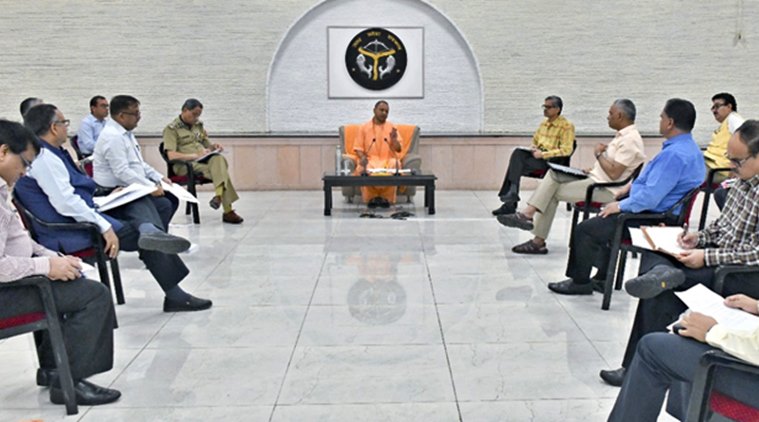 CM Adityanath chaired a high-level meeting that was attended by the district magistrate, the police commissioner and the chief executive offices of the three local authorities. (File)
CM Adityanath chaired a high-level meeting that was attended by the district magistrate, the police commissioner and the chief executive offices of the three local authorities. (File)
With Uttar Pradesh having already received over 12 lakh migrant workers and another 10 lakh expected to arrive, Chief Minister Yogi Adityanath on Thursday asked officials to turn the lockdown crisis into an opportunity by removing “palayan ka kalank” (blot of labour migration) from the state as he pitched various human resources initiatives to shore up the floundering economy.
“It (the pandemic-induced lockdown) will become the strength of migrant labourers. This is also an opportunity to permanently remove the blot of labour migration from the state,” the CM said during a video conference with officials and bankers.
Lakhs of skilled and semi-skilled workers of Uttar Pradesh migrate to mostly big cities in Maharashtra, Gujarat, Karnataka and Delhi annually.
Uttar Pradesh is the largest out-migration state in the country, according to the Census 2011.
What followed after the announcement of the lockdown late in March was salary cuts, job losses and a freeze in the economic activity, resulting in a slump in demand across all sectors. Small businesses were the worst hit as they could not withstand the lockdown pangs and were forced to retrench workers.
To prevent unemployment among the returned workers, Adityanath directed officials to enumerate their skills and help them with employment opportunity in line with their capability.
Adityanath also asked officials to ensure that Uttar Pradesh got the biggest share of the special package announced by the Central government for the medium, small and micro enterprises (MSMEs). “Kal itna bhari bharkam package ghoshit hua hai, uska sabse bara hissa UP mein ana chahiye (Yesterday, such a big package has been released. The biggest share should come to UP).”
Stressing that the Rs 2,000-crore MSME loans would provide employment opportunity to about 2 lakh people, he said nearly 25 lakh labourers were employed under the Mahatma Gandhi National Rural Employment Guarantee Act (MGNREGA). The loans were disbursed to 57,000 MSMEs on Thursday.
The Chief Minister also launched ‘Sathi’ portal for the MSMEs.
He also set an ambitious target of providing jobs to 50 lakh labourers under MGNREGA by the end of this month.
Though there is no segregation of usual or migrant labourer data, officials said that till last fiscal year, the average number of labourers engaged in MGNREGA at a time was between 15 and 16 lakh.
He assured investors that their investment would not be wasted as the state government was providing support to everyone in monitoring each activity. “You (investors) should not worry. Your capital is safe here,” he said.
He stressed that in the next five years, UP’s per capita income would double – courtesy MSME sector – on par with the national income. Currently, its income is close to half of the national average. He said it was one-thirds of the national income in 2016.
Pitching for indigenous products, the chief minister said artists and businessmen here were as productive and innovative as that of China. Earlier, Prime Minister Narendra Modi. In his televised address to the nation, urged people to strive to be self-reliant by using local products.
Blaming China for the spread of the novel coronavirus, Adityanath said there was no need to import idols from China for Diwali as the same can be made by the terracotta industry of Gorakhpur under the One District, One Product scheme. Gorakhpur recently received GI tagging for the product.
In another example of domestic potential, the Chief Minister said Bhadohi exported carpets worth Rs 4,000 crore annually; Moradabad shipped out brass items worth Rs 6,000 crore; then there was itra from Kannauj.
Meanwhile, the government issued an order directing all district magistrates (DMs) to ensure effective implementation of ease of doing business reforms in their respective districts. All 75districts will be ranked every month on the basis of three parameters – time-bound disposal of applications received on the single window portal Nivesh Mitra for getting approvals or licences, ‘Satisfactory’ feedback of Nivesh Mitra users, and timely grievance redressal status of the district.
Industrial Development Minister Satish Mahana said the government was confident that on the back of district-level ease of doing business ranking initiative, the state would see impressive entrepreneurs’ facilitation at the grass root level. “As the state government is gearing up to transform the current challenges into opportunities of bringing in reforms for inclusive development, it is crucial that these reforms are implemented and visible on ground at all levels of governance, including districts,” he added.
Infrastructure and Industrial Development Commissioner Alok Tandon said the step would encourage the spirit of business competitiveness amongst the districts, which would further act as a catalyst in improving the doing business ranking for the state.
According to February 2020 data, there were 17 districts with over 2,000 applications received on Nivesh Mitra. These included Bulandshahr, Prayagraj, Varanasi, Ghaziabad, Aligarh, Muzaffar Nagar, Gautam Budh Nagar, Agra, Saharanpur, Mathura, Bareilly, Lucknow, Gorakhpur, Meerut, Hapur, Kanpur and Moradabad, the release said.
Single window portal of the state Nivesh Mitra is also part of ease of doing business reforms, it added.